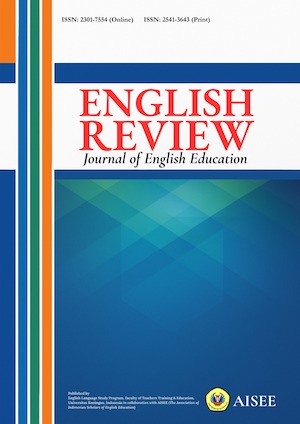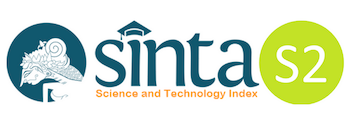GENDER DIFFERENCES IN WRITING ANXIETY AMONG EFL UNDERGRADUATE STUDENTS: A SURVEY STUDY AT UNIVERSITAS JAMBI
Abstract
Writing is a skill that is necessary for success in the academic world. Writing is a necessary activity in education that fosters significant growth in both teaching and learning. However, good writing requires a variety of skills, including a wide vocabulary, the capacity for contextual understanding, analytical strength, the capacity for inference, the capacity for critical thought, and much more. This skill is unquestionably difficult to acquire, especially when writing in English, which naturally puts more pressure and anxiety on students. This study was designed to investigate the types and levels of writing anxiety experienced by EFL students taking an academic writing course at an English department at a university in Jambi, regardless of their gender. The instrument of this study was a close-ended questionnaire that was adopted from Cheng (2004). It consists of 22 statements about different types of anxiety (cognitive, somatic, and avoidance behavior). There were 225 students who participated in the study. Majority of them 82.2% (185 students) were female and only 17.8% (40 students) were male. The results of the study indicated that there are differences in the level of anxiety experienced by male and female students. The highest score of the two genders is in the somatic anxiety type; namely, women have a mean score of 3.36 and men have a mean score of 3.07. Although both have high levels, there is a slight difference in numbers, so women experience higher levels of anxiety than men, and the type of anxiety they have is somatic anxiety.
References
Aydin, S. (2008). An investigation on the language anxiety and fear of negative evaluation among Turkish EFL Learners. Asian EFL Journal, pp. 421-444.
Ali, T.T. & Fei, W.F. (2017). Foreign language classroom anxiety among Iraqi students and its relation with gender and achievement. International Journal of Applied Linguistics and English Literature, 6(1), pp. 305-310. https://doi.org/10.7575/aiac.ijalel.v.6n.1p.305
Cheng, Y. (2002). Factors associated with foreign language writing anxiety. Foreign Language Annals, 35(5), pp. 647-656.
Cheng, Y. (2004). A measure of second language writing anxiety: Scale development and preliminary validation. Journal of Second Language Writing, 13, pp. 313-335. https://doi.org/10.1016/j.jslw.2004.07.001
Creswell, J.W. (2016). Research design: Pendekatan metode kualitatif, kuantitatif, dan campuran. Pustaka Pelajar, Yogyakarta.
Fajaryani, N., Mukminin, A., Hidayat, M., Muhaimin, M., Haryanto, E., Nazurty, N., Habibi, A., Marzulina, L., & Harto, K. (2021). Cultural capital and argumentative writing in English: Challenges and strategies used by EFL student teachers. The Qualitative Report, 26(10), 3029-3045. https://doi.org/10.46743/2160-3715/2021.4784
Ghozali, I. (2006). Aplikasi Analisis Multivariate dengan Program SPSS. Badan Penerbit Universitas Diponegoro.
Ho, M. (2016). Exploring writing anxiety and self-efficacy among EFL graduate students in Taiwan. Higher Education Studies, 6(1), pp. 24-39. https://doi.org/10.5539/hes.v6n1p24
Jafari, N & Ansari, D. N. (2012). The effect of collaboration on Iranian EFL learners’ writing accuracy. International Education Studies, 5(2), pp. 125-
Jebreil, N., Azizifar, A., Gowhary, H. (2015). Investigating the effect of anxiety of male and female Iranian EFL learners on their writing performance. Procedia: Social and Behavioral sciences, pp. 190-196. 3rd World Conference on Psychology and Sociology, WCPS-2014. https://dx.doi.org/10.1016/j.sbspro.2015.03.360
Kumar, R. (1999). Research methodology: A step-by-step guide for beginners. Sage.
Kusumaningputri, R., Ningsih, T.A., Wisasongko. (2018). Second language writing anxiety of Indonesian EFL students. Lingua Cultura, 12(4), pp. 357-362. https://doi.org/10.21512/lc.v12i4.4268
MacIntyre, P. D., & Gardner, R. C. (1991). Language anxiety: Its relationship to other anxieties and to processing in native and second languages. Language Learning, 41(4), pp. 513-534.
Mathew, P., Job, L.M., Al Damen, T., Islam, M.R. (2013). An Arab EFL context: Does variance in anxiety and motivation across gender impact language attainment? Studies in Literature and Language, 6(3), pp. 14-22. http://dx.doi.org/10.3968/n
Miri, M.A., & Joia, J. (2018). Writing anxiety in an Afghan EFL setting: Voices from five Afghan students. Journal of Foreign Language Teaching and Learning, 3(1), pp. 14-29. https://doi.org/10.18196/ftl.3125
Moidunny, K. (2009). The effectiveness of the national professional qualification for educational leaders (NPQEL). Unpublished Doctoral Dissertation, Bangi: The National University of Malaysia.
Rabadi, R., & Rabadi, A. D. (2020). Do medical students experience writing anxiety while learning English as a foreign language? Psychology Research and Behavior Management, 13, pp. 883-893. https://doi.org/10.2147%2FPRBM.S276448
Rezaei, M., & Jafari, M. (2014). Investigating the levels, types, and causes of writing anxiety among Iranian EFL students: a mixed method design. Procedia: Social and Behavior Sciences, 98, pp. 1545-1554. https://doi.org/10.1016/j.sbspro.2014.03.577
Sabti, A. A., Md Rashid, S., Nimehchisalem, V., & Darmi, R. (2019). The Impact of writing anxiety, writing achievemalet motivation, and writing self-efficacy on writing performance: A correlational study of Iraqi tertiary EFL Learners. SAGE Journals, 9(4), https://doi.org/10.1177/2158244019894289
Salikin, H. (2019). Factors affecting male and female Indonesian EFL students’ writing anxiety. Indonesian Journal of Applied Linguistics, 9(2), pp. 316-323. https://doi.org/10.17509/ijal.v9i2.20229
Sulfiana, F., Kurniawati, N., & Nurwanti, D. I. (2022). Indonesian EFL Students’writing Anxiety in Post-Pandemic Online Classroom Context: A Survey. International Journal of Research on English Teaching and Applied Linguistics, 2(2), 26-36. http://dx.doi.org/10.30863/ijretal.v2i2.2452
All articles published in English Review: Journal of English Education (ERJEE) are licensed under the Creative Commons Attribution 4.0 International License (CC BY 4.0).
Copyright Ownership
Authors retain the copyright of their articles and grant ERJEE the right of first publication. The journal is granted a non-exclusive license to publish, reproduce, and distribute the article in any format, medium, or platform, provided that proper credit is given to the original authors.
License Terms – CC BY 4.0
Under the Creative Commons Attribution 4.0 International License, others are free to:
- Share — copy and redistribute the material in any medium or format
- Adapt — remix, transform, and build upon the material for any purpose, even commercially
As long as they:
- Provide appropriate credit to the original author(s) and source
- Provide a link to the license (https://creativecommons.org/licenses/by/4.0/)
- Indicate if any changes were made
There are no restrictions on the reuse, reproduction, or adaptation of published articles as long as attribution is properly given.
Author Warranties
By submitting a manuscript to ERJEE, authors confirm that:
- The work is original and does not infringe any existing copyright.
- The manuscript has not been previously published and is not under consideration elsewhere.
- All sources and references are appropriately acknowledged.
- Necessary permissions have been obtained for any copyrighted materials used.









